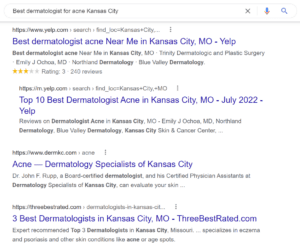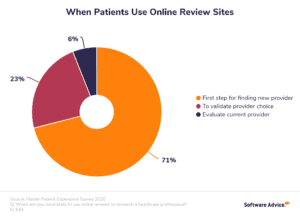Today’s patients often feel more comfortable researching online and making independent decisions on which provider to choose. And with dermatology, providers must simultaneously educate consumers on the importance of dermatology and capture patients needing an urgent solution. Therefore, dermatology digital marketing strategies must cover the entire funnel with local SEO, content marketing, PPC ads, and even Facebook ads.
Dermatology Digital Marketing
Skin cancer is the most common cancer in the United States, and approximately 9,500 people in the U.S. are diagnosed with skin cancer daily. However, consumers rarely consider dermatology a high-priority healthcare item. Therefore, it’s up to dermatologists to educate consumers and put themselves in front of the right audience.
And what’s a better way to do so than leveraging the digital space, where consumers actively look for information and solutions?
With an effective dermatology digital marketing strategy, you can target TOF patients who don’t yet have dermatology as part of their healthcare routine and BOF patients who are eagerly searching for a provider.
Four Types of Dermatology
If you’re a dermatologist, your practice most likely falls into one of the four following subcategories:
-
- Dermatopathology: the study of disease identification using hair, skin, and other tissue samples
- Pediatric Dermatology: dermatology healthcare for children
- Mohs Surgery: mainly focuses on skin cancer treatment
- Cosmetic Dermatology: using dermatology treatments to improve skin appearance
Each subcategory comes with its advantages and nuances with digital marketing. For example, cosmetic dermatology is an elective and requires a more robust digital marketing strategy to build demand for your services. Meanwhile, pediatric healthcare services have stricter marketing compliances. On the other hand, Mohs surgery primarily relies on referrals and thus has more B2B aspects to its digital marketing. In contrast, dermatopathology must focus more on why it is essential to get diagnosed instead of actual treatment procedures.
Website Design for Dermatologists
Regardless of your subcategory, all dermatologists must start with their website. After all, your website is your digital front door.
When building a dermatology website, begin with the basics. Provide a comfortable user experience with easy-to-read fonts, professional images, and clear CTA to help patients move forward to the next step. Meanwhile, optimize your website for mobile devices since 62.06% of website traffic now comes from mobile devices. Your website must be responsive and fast.
Remember, user experience should always come first.

Learn how we helped VitaSkin build a patient-generating website
Make Reaching Out Easy
Since patients come to your website for information, explain your treatment programs, specialties, intake procedure, and insurance information. Once you’ve answered all of their questions, create multiple ways to get in touch with you.
Maybe they want a consultation? Submit a contact form to get specific answers from real doctors. Would you rather speak with someone now? The tap-to-call function and chatbots are great ways to engage with your website visitors on the go. And, of course, create a booking link so patients can get their first appointment scheduled in a few clicks!
Local SEO for Dermatologists
Like most other healthcare services, dermatology is a local service. Consumers would much rather visit a provider nearby than drive an extra thirty minutes out of their way. Therefore, local SEO is the bread and butter of any dermatology digital marketing strategy.
Citations & Listings
Your first step to winning local SEO would be creating high-quality listings on trusted local directories. Yelp, Trip Advisor, and ZocDoc are great places to start. Niche-specific directories like Find A Dermatologist are also great tools to increase local visibility. Ensure that your name, address, and phone number (NAP) are consistent across all listings.
Google Business Profile (GBP) Optimization
64% of consumers have used Google Business Profile (Formerly Google My Business) for contact information for a local business, whereas 77% of patients use Google before scheduling an appointment.
Optimize your GBP listings for each location. Provide the most accurate information, share photos of your practice, and create an FAQ to answer patients’ questions about your treatment programs, pricing, and accepted insurance.
Geographical Keyword Strategy
Geographical keywords are often BOF keywords, meaning the patient is only one step away from buying. Examples of high-intent geographical keywords include
- Skin cancer treatment in Chicago
- Pediatric dermatologist near Lake Forest
- Best dermatologist for acne Kansas City

When choosing keywords, optimize for solution-aware keywords that indicate the specific treatment you provide or insurance you accept, as these keywords are more likely to capture a conversion-ready patient.
Well-optimized Location Pages
Finally, optimize your location pages individually. Similar to your GBP listings, provide accurate and location-specific information to capture consumers in each target market. For example, create a staff section introducing the practitioners at each branch and a treatment section highlighting the specific treatments offered at that location.
And again, remember to optimize for mobile devices.
Content Marketing for SEO
Dermatologists must create informative content for TOF and MOF consumers so they understand why dermatology should be a part of their healthcare routine. Therefore, creating optimized articles answering patients’ questions about skin conditions and symptoms will bring you in front of a researching consumer.
When creating your content strategy, consider industry trends and keyword research. For example, when we worked with VitalSkin, we developed a scalable content strategy with a robust internal link structure. These blogs informed users of skin conditions, generated TOF awareness, and enhanced the website experience.
Total Alignment of Dermatology Marketing with Operations
While effective digital marketing is vital for dermatology practices, true success comes from aligning these efforts with operational capabilities. It’s not enough to simply attract patients; marketing must support overall business goals and enhance patient experience.
As you may know, marketing doesn’t exist in a vacuum—it must serve the practice’s broader needs, which extend beyond patient acquisition. By aligning marketing with operations, dermatology practices can sustainably attract suitable patients.
There are four key areas that require total alignment:
Capacity-Driven Alignment
Are you managing multiple dermatology locations? If so, you’re likely facing a common challenge: balancing patient loads across different sites. Have you noticed some locations struggling to fill appointments while others are always at full capacity?
Here’s the thing—aligning your marketing with each location’s capacity can be a game-changer. As such, let’s talk about how to match your marketing to your actual patient capacity needs.
To achieve this alignment:
- Establish a regular reporting system between operations and marketing teams. Weekly or bi-weekly capacity updates allow marketing teams to adjust their efforts swiftly.
- Use location-specific landing pages and ad campaigns. This enables easy adjustment of marketing efforts for individual clinics based on their current capacity.
- Implement a centralized booking system showing real-time availability across all locations. This will help distribute patients more evenly and improve overall satisfaction.
By aligning marketing with capacity, you’ll optimize ad spend, enhance patient experience, and maintain a balanced workload for your staff across all locations.
Service Line Alignment
Dermatology practices often offer various services, each with different business implications. Understanding the profitability, patient lifetime value (LTV), and upsell potential of other services can significantly impact your marketing strategy.
To align your marketing with your most valuable service lines:
- Collaborate closely with your finance team to understand the business metrics of each service.
- Create targeted campaigns for high-LTV services. For instance, if cosmetic dermatology patients tend to become long-term, loyal patients, consider increasing marketing efforts for these services.
- Develop upsell pathways in your marketing. If patients who come in for acne treatments often benefit from chemical peels, create content that educates acne patients about the benefits of peels.
Remember, the goal isn’t just to bring in any patients, but to attract those who will benefit most from your services and contribute to your practice’s long-term success.
Messaging Alignment
In the competitive field of dermatology, your marketing messages must align with your practice’s capabilities. Misalignment between marketing promises and operational realities can lead to patient frustration and staff burnout.
To ensure messaging alignment:
- Bridge the gap between marketing and patient care. Why not invite your dermatologists and nurses to brainstorm marketing ideas? Their frontline experiences can inject authenticity into your campaigns.
- Turn patient feedback into a strategic asset. How about creating a joint task force of marketers and operational staff to dissect patient reviews regularly? This could uncover any misalignments between your promises and actual service delivery.
- Craft a brand bible. Have you considered developing an interactive digital guide that captures your practice’s essence? Make it easily accessible to all staff, from receptionists to senior dermatologists.
- Harness the power of real patient journeys. What if you set up a simple system for your clinical team to flag remarkable patient stories? These gems could breathe life into your marketing efforts and showcase your actual impact.
Aligning your marketing messages with operational realities will build trust with your patients and create a more cohesive brand experience.
Technology Alignment
As you might know, technology plays a crucial role in both marketing and operations. However, adopting new technologies often requires significant workflow changes in your clinical staff. Achieving alignment in this area can lead to more efficient, data-driven practices that better serve patients.
To achieve better technology alignment:
- Again, involve both marketing and operations teams in technology decisions. This ensures that new tools will benefit both sides.
- Provide comprehensive training for all staff members who will be using new technologies. This investment in training can significantly smooth the adoption process.
- Start with a pilot program. Test new technologies in one location or department before rolling them out practice-wide.
- Regularly solicit feedback from staff using new technologies. This can help identify areas for improvement and make staff feel valued.
Successful dermatology marketing isn’t just about packing your waiting room but finding the right fit. Think of it as matchmaking for your practice. You want your marketing and operations to work together like a well-coordinated skincare routine. After all, what’s the point of attracting a flood of patients if you can’t deliver on your promises?
Dermatology Reputation Management
Dermatologists need a positive reputation to succeed in digital marketing. A 2020 report indicates that 71% of patients “use online reviews as the first step to finding a new doctor,” and 43% would go out of their insurance network for a provider based on reviews.

On the other hand, a positive reputation also makes referral easier. Your referral partners will feel more comfortable sending you quality leads over your same-region competitors if you have a positive online reputation.
Getting More Positive Reviews For Your Practice
Getting positive reviews is not rocket science; it just takes persistence and a process. Dermatologists can use a few simple strategies to generate online reviews. First, normalize asking for reviews and train your staff on best practices. Then, you can start with your loyal patients, asking them in person after an appointment.
Next, make leaving reviews easy. Provide multiple channels and ways to give reviews, so your patient has choices. You can also invest in review-collecting software, such as a text-to-rate tool like Birdeye or Podium. These technologies can integrate with your CRM and send automated requests via email or SMS after an appointment. Finally, don’t forget to publicize your positive reviews!
Find out how to gather more positive reviews
Online Reputation Management Best Practices
Reputation management is more than reviews. Create an engaging About Us page and invest in media relations to establish your doctors as experts in the field. For example, as a part of VitalSkin Dermatology’s link-building strategy, we reached out to general health publications that publish digital content related to various dermatological themes.
Google Ads Strategies For Dermatologists
Google PPC ads are a game changer for dermatologists to capture BOF consumers who are ready to purchase. With PPC ads, you can target high-intent, dynamic geographical keywords such as “Mohs treatment near me” or “acne treatment near [location]” and place yourself directly in front of the audience on top of the SERP.
Google Ads Account Structure for Dermatologists
Multi-location dermatology service providers will benefit the most from a hybrid account structure. As the name indicates, this account structure sits in the middle of the modern Google Ads account spectrum.
On the one end, you have the segmented structure focusing on budget control and detailed targeting, often by location. On the other end sits the consolidated structure that consolidates ad groups to maximize impression and allows Google’s smart bidding algorithm to shine.
Combining both strengths, the hybrid structure allows you the budget control segmented structure provides without sacrificing a consolidated account’s bidding efficiency and impression scalability.
Google Ads Best Practices
Once you’ve developed the appropriate account structure, let your ads run until you have enough data for conversion and bidding optimization. Meanwhile, create campaign-specific landing pages optimized for mobile devices. Tailored content on these pages gives patients what they’re looking for.
Additionally, dermatologists benefit the most from a full-funnel paid ads strategy since many consumers require some education before understanding why regular dermatologist visits are necessary. However, you should always maximize BOF lead capture first before moving up the funnel for those less aware of their solution.
Try these Google Ads best practices for dermatologists
Social Media Ads For Dermatologists
Social media advertising is a great method for dermatologists to engage with their audience and build their reputation and demand.
When developing a paid social media strategy for dermatologists, focus on building full-funnel strategies. This means understanding how consumers move through the patient journey and capturing their attention at each stage.
Generally, your Facebook traffic falls into one of the three categories: awareness, consideration, and decision.

You can create a social media carousel infographic for patients at the awareness stage showcasing different skin conditions. You can also create a downloadable guide of how each stage of skin cancer looks to prompt patients to take action, or even use AR mini-games to project the conditions onto their bodies!
For solution-aware MOF patients, promote your treatment programs and leverage instant experience and other functions to make conversion easy. You’ll find helpful templates under Facebook’s consideration.
Finally, craft call-to-action ads with easy conversion for patients at their decision-making stage. Leverage instant experience for quick appointment booking or create call ads on mobile. Remember: always maximize BOF lead capturing first!
Learn more about full funnel Facebook ads strategies for dermatologists
Google Ads Before Paid Social
Again, while paid social is an effective dermatology digital marketing strategy, it focuses more on TOF and MOF leads. Therefore, you shouldn’t look into paid social until you’ve built a digital marketing foundation.
Invest your time and money in a good website and strong local SEO first. Next, nail down your PPC ad strategy and maximize BOF lead capturing. After all, those are leads looking for immediate solutions and will maintain your revenue while your paid social ads prepare TOF and MOF patients for acquisition.
Meanwhile, develop an organic social media strategy. After everything is done, if you still have some budget, you can look into paid social media ads and see if they align with your marketing goals.
Learn when it’s the right time to invest in Facebook Ads
Telehealth Marketing for Dermatologists
New technologies created a significant impact on how patients access dermatology services. For example, the COVID-19 pandemic forced consumers to shift from in-person healthcare to telehealth.
Similarly, skin cancer detection apps have been changing the tides of dermatology digital marketing strategies. For example, Miiskin is a paid app that allows you to take high-res photos of large parts of your body to track moh development over time. Meanwhile, MoleScope lets you send photos taken to a dermatologist for an online opinion.
Telehealth Marketing Best Practices
If you offer telehealth, market it to the fullest because it gives you a competitive edge over other providers who don’t have telehealth ability.
Start with finetuning your messaging. Respond to your patients’ unique challenges, such as being unable to commute to a dermatologist due to schedule or transportation limitations. Once your offer is ready, look into PPC ads to capture patients seeking teledermatology services.
Although more people are getting acquainted with telehealth, it’s still necessary to create educational content on how teledermatology is as efficient as in-person visits. Additionally, successful telehealth stories are also useful to your telehealth marketing strategy.
Find out how to market your telehealth dermatology services
Gaining Clarity With Marketing Analytics
Data-driven digital marketing provides clarity for dermatologists. With centralized analytics, you can evaluate your marketing efficiency to adjust and optimize your strategy for maximized performance.
Dermatologists should implement closed-loop reporting (CLR) to review how each digital marketing piece affects the patient journey in the larger picture.
When implementing CLR, choose your attribution model wisely
- First-touch model captures the initiation points of a patient’s journey
- Last-touch model captures the last interaction before conversion
- Multi-touch model assigns credits proportionally to every interaction point throughout the patient’s journey
- Linear model maps the patient journey by assigning credits to each interaction the patient made up till conversion
Data-Driven Marketing Best Practices
Integrate all your systems and channels to gather comprehensive analytics, such as Search Console, Google Analytics, your CRM system, and social media analytics. Choose different metrics for each goal for accurate assessment, and don’t forget to track activities outside of the digital system, such as direct calls and in-person visits, to complete your loop. Meanwhile, eliminate unnecessary silos and build an interactive, responsive, cross-department dashboard to help your team collaborate.
Learn more about how to measure healthcare marketing performance
Conclusion
Digital marketing strategies for dermatologists should always start with developing a future-proof website optimized for mobile devices. Then, invest in local SEO to put your organization in front of patients in your local market. Next, ensure your operations are aligned with your marketing efforts.
Once you’ve built the foundation, develop a lean, effective account structure for Google PPC ads to quickly scale your patient acquisition. If you have budget left, consider investing in paid social media ads and engaging with patients throughout the funnel. You can also invest in new technologies like telehealth services or skin cancer apps.
Ultimately, digital marketing for dermatologists is about staying ahead of industry trends and connecting with local patients while covering the entire funnel to create a sustainable patient acquisition model.

